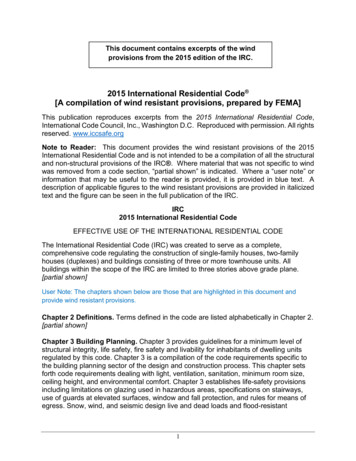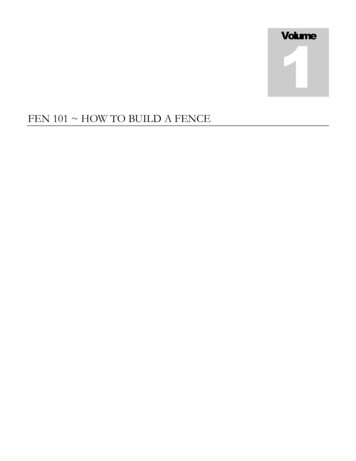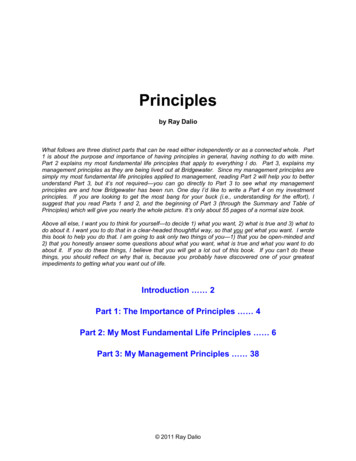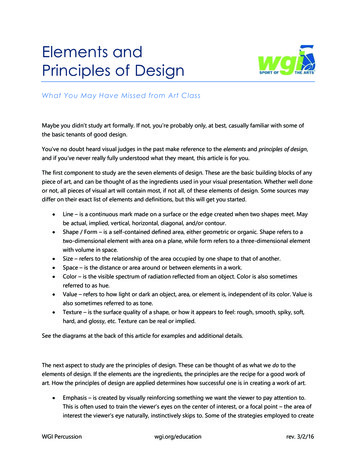
Transcription
Residential Development: Principlesfor Good DesignSeptember 2013 - DRAFT
This supplementary guidance was produced by Planning and Building Standards and should be read in conjunction with the approved Local DevelopmentPlan.Further copies of this guide can be downloaded ronment/planning-and-building-standards/For further advice please contact the team on 01389 738575 or visit the offices atCouncil Offices, Rosebery Place, Clydebank.Published: September 2013
3Contents Page1. IntroductionBackground About this Guide How to use this Document Getting the Fundamentals Right Local Context Design-Led Six Qualities Supporting Documents4-52. Character and SettingDistinctive Character Design and Access Statements Natural Features Streetscape Street Patterns Building Lines Scale,Massing and Height Densities Listed Buildings Local Materials Legibility6-73. Layout and Plot SizesRelationship of plots Level One—Site Layout Local Patterns of Development Densities Massing and Proportion Permeability Public Transport Orientation Natural and Built Features Public and Private Space Mix of Uses Level Two—House to House Minimum Distances Overlooking and Privacy The 18m Rule Level 3—Site Layout Plot Ratios Narrow Plot Widths Driveways Bin provision8-114. House DesignExternal constituent parts Roof Lines Pitch Proportion Windows and Doors Elevations Other Features Garages Materials Corner Buildings Primary Access12-135. Landscaping, Open Spaces and Play AreasGreen Network Green Infrastructure Entrance and Gateways Existing Landforms Structural planting, shelter belts, greenwedges and green corridors Watercourses Enhance Local Views and Features Multi-functional Spaces Fit for Purpose Play Areas Design of SUDS14-156. Roads and ParkingDesigning Streets Place before Movement Six Qualities and Street Design Street Design Hierarchy Street Structure PedestriansFirst Connections to Surroundings Connections Within Block Structure Walkable Neighbourhoods Public Transport Contextand Character Orientation Street Layout Traffic Calming Measures SSDs Junction Types Turning Areas Frontage Access Streets for People Integrated Parking Waste Collection Vehicles Street Detail Materials Signs and Street Markings Lighting16-217. Community SafetyNatural Surveillance Sense of Ownership Defensible Space Permeable Sites Boundaries Car Parks Planting Play Areas Youth Shelters Footpath Design Good Lighting Signage22-238. Planning Application ProcessPre-Application Discussion Area Teams Processing Agreements Statutory Consultees Major Development OnlineSubmissions Local Development Planning Committee Hearings Planning Obligations Planning Gain24-25
41. IntroductionBackgroundSince the early 2000s there has been an emphasison good design in the planning process fromgovernment policy documents and mainstreamthinking. Design is a material consideration indetermining planning applications and there is agrowing recognition of the added value that designcontributes to development. Many exemplarschemes now exist in Scotland to put theory intopractice.Fundamentally the key policy documents fromScottish Government advocate a design-ledapproach rather than a standards-based approachand the use of supplementary planning guides(SPGs) are recommended to local authorities to setout their requirements to developers.About this GuideThis SPG applies to housing developments from 3units to 300 units. It seeks to inform developers ofthe standards of development required and thecriteria used by planners to assess such proposals.It seeks to inform and is a flexible documentdesigned to create innovative and contextsensitive designs.This guide complements the local development plan(LDP) and reference should be made to it prior tosubmitting an application. It should be noted thatthis guide is a draft and part of the consultation andreview process of the LDP.Residential Development: Principles for Good DesignHow to Use this DocumentPage five sets out what fundamental principles allschemes should demonstrate. There are then sixsections which cover:Character and SettingLayout and Plot SizesHouse DesignLandscaping, Open Spaces and Play AreasRoads and ParkingCommunity SafetyEach section includes a checklist of the criteria to beconsidered. The final section summarises theplanning application process.
5Getting the Fundamentals RightThe fundamentals of any development should bethat it:gives importance to the local context;is design-led, not standards-led;promotes the six qualities of good design;andis accompanied by appropriate supportingdocuments.Local ContextWest Dunbartonshire is made up of a number oftowns and villages within a broadly urban area butwhich are in close proximity to the Local LandscapeArea. Historically, settlement patterns and towngrowth have varied resulting in areas having theirown local character. Consideration of the localcontext is fundamental to bringing forward asuccessful scheme and any housing project shouldstart with an assessment of what is there.Design-LedAll schemes should be design-led where the finalproposal is based on a systematic assessment ofthe site and not the imposition of standards on asite. Street design should consider place beforemovement.Six QualitiesThe six qualities originate from “DesigningPlaces” (2001) and was the first national policystatement which subsequent design documentsrefer to. These six qualities, shown in inset Box 1,are at the heart of good design and all schemes arerequired to promote them.Supporting DocumentsAll national and major developments should includea Design and Access Statement and they arestrongly encouraged for local developments within/near sensitive sites. The Design Statement will beassessed against the criteria set out in PAN 68“Design Statements” and it is therefore prudent tocarefully consider the requirements and checklistsset out in PAN 68.The requirement for EIAs, TransportationAssessments, Flood Risk Assessments, SiteInvestigative Reports, Tree Survey Reports, etc,should be discussed with DevelopmentManagement prior to submission of an application.These pre-application meetings are alsoencouraged to discuss/resolve issues at an earlystage.Box 1 Six qualities of good designResidential Development: Principles for Good Design
62. Character and Setting“Does the proposaldisplay character,identity andvariety?”All new proposals for housing should seek to createareas which have a distinctive character related tothe local setting - areas which will give people prideand a sense of community and belonging. It isessential to understand the setting of a site so thatthe resulting layout and design is informed.Where there are established building linescontinuity is maintained by integrating new buildingswith existing buildings and structures.Buildings that relate to a common building linereinforce and define the street. Projections andsetbacks are useful in certain locations to addemphasis, provided continuity is not lost.The starting point is to appraise the features of thesite and surrounding area to determine the naturaland built environment. Design and AccessStatements should be used to enable a full andconsidered assessment of the site.Natural features can help give shape to adevelopment and integrate with its surrounds. Theemphasis should be on conserving and enhancingthe site’s features whether it be open watercourses,retaining trees or avoiding large-scale levelling.These features can often form the focal point of thedevelopment.Every element of the streetscape contributes to asense of place—not just the house but the hardstanding, the landscaping, the street pattern, parkinglayout, boundary treatment, public/private space—itall comes together to create a unique development.Street patterns represent the history andconnections of an area and reflecting them in thenew development can help integrate a site as wellas improving movement.Residential Development: Principles for Good Design[Building lines—of local streeteg Dumbarton Rd, Glasgow Rd]The scale, massing and height of new buildingsshould be considered in relation to adjoiningbuildings. It may be appropriate to use a variety ofdensities within a site, for example, as focal points,at natural low points within a site or to complementoutlooks from the site and frame natural/man-madefeatures.Consideration should be given to any listedbuildings or conservation areas within the vicinity.
7Distinctive areas can be created using local buildingforms and the use of local materials andarchitectural detailing is encouraged.Is there an appraisal of the local area/history ?Are there natural features or trees on the sitewhich can be incorporated into the layout?Are there any natural assets which can beenhanced?Does the development face any watercoursesor canals?Does the housing fit into the landscape or is itvisually dominating?A site needs to be legible—a place that is easy forusers to understand and navigate. Users need tobe able to see important routes and landmarks anda site should seek to maintain and enhance existingviews and create new ones.Is the streetscape well integrated with itssurrounds?Are the existing street patterns being used toform connections into site and set block sizes?Are established building lines being used?Does the new proposal relate well to the scale,massing and height of adjacent buildings?Can local building forms and local materials beused to create distinctiveness?Is there variety of building form?The use of good signage, lighting and public art canall aid legibility and help create a unique anddistinctive character.Is the site legible for users? Does it need to becomplemented with signs/lighting/public artat key points?Residential Development: Principles for Good Design
83. Layout and Plot Sizes“Plots need torelate well to thehouses being builton them, to eachother and to thesurrounding area.”One of the main concerns with the current housebuilding market is the dissatisfaction with the layoutof modern estates with their loss of front gardens tothe car, small rear gardens, buildings too closetogether and general lack of public open space andadequate playing facilities.Plots need to relate well to the houses being builton them, to each other and to the surrounding area.If consideration is given to each of these three levelsthen the result will be a well-designed and attractivedevelopment.LEVEL ONE—SITE LAYOUTSite layout considers the bigger scale of how a sitefunctions within and relates outwith. Local patternsof development should be used as a basis forresidential proposals as they inform how newhousing can integrate into existing patterns ofstreets and paths and what appropriate density,scale and massing might be.Densities should reflect the context of the site andlayouts can incorporate different densities within theone site to provide interest and variety.The massing and proportion of developmentsneeds to be right to ensure development looks rightin its setting and has a “human scale” to it. In gapsites modern design materials can be used to greateffect if the new buildings have the same massingand proportion.Residential Development: Principles for Good DesignImportant to how a site functions is itspermeability. Places need to be easy to get toand move through for pedestrians and cyclists.New routes should connect into existing routes,creating small blocks of development, and moveaway from the cul-de-sac arrangement, common inmany house developments.Layouts should have well-connected streets andactive road frontages where the front elevation ofthe building faces the street not the rear elevation.Buildings should frame public spaces with directaccess to the street. Layouts should incorporate anetwork of spaces and streets with these spacesused to create identifying features.Public transport facilitiesshould be designed in andlayouts sought whichminimise walking distancesto local facilities. They needto be designed to be able tobe served (see Roads andParking).Houses should be orientated to take into accountcorner plots, any natural features on the site andexisting streets. Buildings orientated away fromstreets often leads to high fences and walls on thestreet. Instead buildings should be positioned toface one another to allow natural surveillance.Care needs to be taken with houses on cornerplots—they should be set back or angled to facefeatures on a site rather than L-shaped and tight tothe road. If this is not possible then double frontagedwellings may work.[diagram illustrating this]
9Natural and built features on a site should beemphasized and any views in/out of a site shouldbe maximised. Entrances to places need to give agood first impression. On sloping sites buildingsshould step up making use of the contours of thesite and avoid under building.Public and private space needs to be clearlydefined. Gates and overlooking windows should beused to control access to private areas and theextent of private ownership around a building e.g.railings, paving, walls, help define the boundarybetween public and private space.Are local patterns of development beingused to inform layout?Are uniform densities being avoided?Does the massing and proportion of thecomponent buildings relate to the setting?Is the site easy to get to and move throughfor pedestrians and cyclists?Do new routes connect into existing routesand have meaningful destinations?Is the principle of active frontage beingemployed?Is the public transport network easilyaccessible?Large residential developments should consider theintroduction of areas set aside for future amenityprovision such as shops, nurseries, leisurefacilities, community halls, etc. Introducing a mixof uses may be appropriate for some sitesprovided those uses are compatible and housedensities enable these uses to be viable.Does the orientation of buildings reflect thestreet patterns/other features on the site?Are there natural/built features or views tobe protected or enhanced?Does open space have a clearly definedpublic/private edge?Is there opportunity for introducingappropriate alternative uses into a purelyresidential site?Residential Development: Principles for Good Design
10LEVEL TWO—HOUSE-TO-HOUSEThis level considers how well houses relate to eachother. There is no set minimum distance betweenhouse gables—the gap will depend on the housetype, setting, the provisionof driveways and ensuringthat plots allow for futureexpansion. In generaldetached houses shouldhave a more generous gapand it is suggested that 3mwould allow a driveway tobe formed at one side.Properties should not look into other properties.Walls, fencing and landscaping can be usefulmeans of screening within a site to preventoverlooking or loss of privacy.To ensure that adequate levels of privacy aremaintained for new and existing occupiers, windowto window distances should be applied. The 18mrule is a recognised and useful tool and requires thedistance between windows of directly facinghabitable rooms (living rooms, dining rooms andbedrooms) to be 18m as shown below.Where properties are angled the distance can bereduced and in the scenario of a corner windowthey should be at least 2m apart.Box 3: Window-to-window distances for corner windowsDoes the gap between houses reflect thehouse type and setting/context of site?Do the distances between properties allowfor driveways and/or future extensions?Has privacy been assessed using window-towindow distances?Box 2: Window-to-window distancesResidential Development: Principles for Good DesignAre walls, fencing or landscaping requiredto prevent overlooking within/outwithsite?
11Plot ratios are not usedLEVEL THREE—HOUSE AND PLOTfor flatted developmentsbut they should haveAt a basic level is the relationship between thehouse and the plot. A useful tool for defining what amenity open space tominimum sizes should be is plot ratios. Plot ratios provide a setting for thelink the footprint of the building with the garden size: development as well asoutdoor drying areas, binstores and privateDetached and semi-detached—30:70seating areas.Terraced properties— 40:60So, for example, if a terraced property has afootprint of 80m2 then the garden ground (front andrear combined) should be at least 120m2.Narrow plot widths can promote more activefrontages and allow higher densities. This can beappropriate on some sites where it reflects existingdensities or where active frontages are required butfront gardens shouldn’t be used solely for parking.These ratios are minimum requirements andsurrounding plot sizes will be taken into account.Higher/lower ratios may be appropriate and theseshould be explored in the design statement. Theextent of usable garden ground is just as importantas size.Driveways must be accommodated to the side of thebuilding for detached, semi-detached and endterraced buildings. Mid-terraced properties shouldonly have driveways in the front garden where it canbe demonstrated that they cannot be accommodatedelsewhere on the street or to rear of property. Thisshould not be at the expense of the garden or lead tocars dominating the streetscape.The Council operates a separate-at-source policy fordomestic waste and adequate provision needs to bemade for the different bins required. Lane accessmay be required for mid-terraced properties.Does the house and gardencomply with the plot ratios?Does the plot provide privateusable garden ground?Are there separate spaces forbin stores and drying greens?(flats and houses)Can a driveway be providedthat is not in the front garden?Is there adequate provision forthe storage of sorted waste andcan this be accessed easily byresidents and uplift serviceproviders?Residential Development: Principles for Good Design
12“There is a need tomove away fromthe standard housetypes commonlyfound in WestDunbartonshiretowards a moreinnovative andcontext-led housedesign.”4. House DesignElevations - interest to a plain wall or a large flattedblock can be achieved using bays and gables andchanges in finishing materials.House design is all about the external constituentparts that make up the building—the roof, elevations, windows, doors, chimneys, porches, garagesand sun-rooms. It considers things such as pitch,height, massing and scale, and the finishing materials are what brings everything together.Features such as chimneys, porches, dormers, sunrooms can all add interest to a design but shouldrelate to local design features and not be overlyfussy.Careful consideration needs to be given to rooflines. The pitch (the angle of the roof) is important:shallow pitches should generally be avoided asshould a bulky or “top-heavy” roof. There can be avariety of roof styles and pitches within largerhousing sites but this is not always necessaryelsewhere.The individual parts of a building should be inproportion to each other, for example, windowsizes and number, roof height to wallhead heightratio.Windows need to look good from the outside butalso provide light and views from the inside. Thenumber, proportion, alignment and type all have animportant part to play in the overall look of abuilding. Neighbouring buildings can give clues asto window proportions. Multiple windows arepreferable to large “picture windows”. Door styleshould compliment house design.Residential Development: Principles for Good DesignGarages can be integral i.e. part of the house ordetached. Detached garages should be set backfrom the front building line and not sit forward exceptwhere the house occupies a corner plot.There are a wide variety ofhouse materials found in theWest Dunbartonshire area:red and blonde sandstone,brick, render, wet dash,natural slates and concretetiles.Some areas are constructed oflocal materials where other areasdo not identify with a local style.Use of local materials will beencouraged.
13The Design and Access Statement should explainthe context of the site and justify the materialsused. The materials proposed should either:enhance the traditional building character; orwhere there is no local style, strengthen thequality of the existing urban make-up.Poor quality materials can spoil a good design.There should be a coordination of materials, colourand proportions. The submission of a palette ofmaterials is encouraged during the processing ofthe application.Is the design of the house influenced by thelocal context?Is there an appropriate diversity of formwithin the site e.g. different house sizes andtypes?Are the individual parts of the building inproportion to each other?Is careful consideration being given to thepositioning, size and alignment of windowsand doors?Are bays/gables/dormers used to add interestto principal elevations?Do additional features such as chimneys andporches relate to local features?Corner buildings need careful design detail.They can help people findplaces or create animpression of an entranceinto a site. In somelocations they need tointegrate with an existingbuilding in terms of heightand building lines.Are detached garages set back from the frontbuilding line?The primary access to a building should be fromthe street. There should be clearly identifiableentrances which help create activity on the streetas well as allowing a building’s function to be“read”. The fronts and backs of buildings can beused in different ways and their design shouldreflect this.Is the primary access to the building from thestreet and easily accessible for pedestrians?Do the finishing materials add quality to thedesign? Are local materials proposed?Are there key locations e.g. corner sites, whichwould merit a different design solution interms of density/height/style?Residential Development: Principles for Good Design
145. Landscaping, Open Spaces and Play Areas“The green networkis a network ofopen spaces suchas play areas,playing fields ,sports pitches,allotments andcemeteries linkedby paths whichstretch into thecountryside.”The provision of landscaping, open spaces and playareas should not be an afterthought but be includedas part of the design process for a site and providedimaginatively.The Council has a vision for a more extensive,functional and better connected network of open andgreen spaces, and residential developments shoulddemonstrate that they will enhance and integrateinto the green network. Green networks provideattractive opportunities for pedestrians and cycliststo move around and developments should seek tocomplete missing links and improve theenvironmental quality of existing links.There are a number of ways in which greeninfrastructure can contribute to a quality residentialenvironment and create pleasant places to live.Entrance and gateways can have formallandscaping, feature trees, or avenues. Existinglandforms, boundary hedges and trees should beintegrated into the development rather thanremoved.Structural planting, shelter belts, green wedgesand green corridors can all assist in integrating thedevelopment into the existing landscape. Streetdesign should aim to integrate natural landscapefeatures and planting helps to soften the streetscene while creating visual interest.Watercourses which run through a site should notThe Council also supports the concept of greeninfrastructure—”the use of ecosystems, greenbe culverted but used as a key feature of the siteand enhanced with appropriate planting.spaces and water in strategic land use planning”where different elements are linked together. Theseelements include water management, habitats,access, green and open spaces.Residential Development: Principles for Good Design
15Other physical features should be retained andenhanced to form local landmarks or enhancelocal views and features, enabling people tonavigate around the larger sites.The key to creating successful open spaces is tomake them multi-functional so that they can be aplay park but also provide SUDS or be a wildlifecorridor and a pedestrian link to local amenities.Open spaces can be formal such as squares, ormore informal such as grassed areas and SUDSponds. All public spaces should be designed witha purpose in mind to ensure they are fit forpurpose and avoid abuse, vandalism and securityissues.They should be overlooked by windows and doorsopening onto the street and by use of bay andcorner windows to give views in different directions.Blank gable walls facing onto public spaces shouldbe avoided. This all helps to reduce anti-socialbehaviour.Play areas should also follow these principles.They need to be fit for purpose and make use ofnatural surveillance. The requirements for playareas are set out in separate supplementaryguidance.SUDS details should be submitted as part of anyplanning application and consideration should begiven to integrate the design of SUDS with thelayout for the green network. SUDS should bedesigned as an attractive integral feature within thedevelopment and work on the following principles:managing surface water run-off on-site as nearto source as possible;slowing down run-off;treating it naturally; andreleasing good quality surface water towatercourses or groundwater.Early discussions on the form of landscaping,where play areas might go and what boundarytreatments are expected are essential.Does the layout include an integratednetwork of landscaping, open spaces andplay areas?Does the layout link into the existing greennetwork?Is the concept of green infrastructureevident?Does planting integrate natural featuresand soften the street scene?Are watercourse and other physicalfeatures on the site enhanced?Is an attractive environment forpedestrians and cyclists proposed?Are spaces multi-functional and publicspaces and play areas fit for purpose?Are SUDS used to form part of the greeninfrastructure of the site?Residential Development: Principles for Good Design
166. Roads & ParkingIn the past road engineering standards oftendictated the layout of housing developments. Roadswere designed to accommodate the movement ofvehicles but were not always attractive or pleasantto walk, cycle or play in.limits and urban structure along with levels ofadjacent development and traffic composition.The place and movement matrix is useful indetermining the importance of a street and helpsinform design choices about that street. Mostresidential sites will have a low movement but highplace function.The publication of “DesigningStreets” (2010) marks a fundamentalshift in the way that roads and streetsare to be viewed. Street design mustconsider “place before movement” sothat successful streets can be createdwhich have a sense of place.West Dunbartonshire Council embraces theconcepts behind “Designing Streets” and thischapter outlines the principles that new residentialdevelopments will have to display. Planning andRoad Services will work closely together to ensurecollaboration between the planning application andRoad Construction Consent processes. It isrecommended that early contact be made with bothto discuss how a scheme might comply with the newroads requirements.Streets need to have other functions as well asmovement of vehicles. They are there to facilitatethe passage of people and cyclists and to contributeto creating a sense of place. A street mightcontribute by being locally distinctive, have a highvisual quality and encourage meeting and playingspaces.Movement and place considerations are important indetermining the appropriate speed designs, speedResidential Development: Principles for Good DesignSource: Designing Streets: Scottish Government 2010Six Qualities and Street DesignAs a starting point the sixqualities (see p5) should beborne in mind when devisingstreet design.
17Streets need to be distinctive by responding to thelocal context of the site. Block structure shouldhave a distinctive form with landmarks and vistasthat provide good orientation and navigation of anarea. The historic elements of a site should beresponded to, to create distinctive places.Streets should be designed to be safe & pleasantplaces. Pedestrians should be considered first andprivate motor vehicles last. Street design should beinclusive. Appropriate traffic speeds should bedesigned into a layout to help drivers reduce theirspeeds to levels appropriate for the context, leadingto safer streets for all.Signs and street markings should be kept to aminimum to help reduce clutter. Street lightingshould be as discrete as possible and streetfurniture should be located for maximum benefitand to reduce pedestrian obstruction. Naturalsurveillance should be maximised whenconsidering orientation of streets/paths. All roadsand paths should have meaningful destinations.Streets need to be easy to move around for allusers and connect well to existing networks. Thiscan be achieved by providing good connectivity,planning public transport links at an early stage anddesigning the urban form with pedestrians in minde.g. junction types.Streets need to be welcoming for all users in thecommunity. They should provide opportunities forsocial interaction and allow walkable access tolocal amenities for all street users. Direct access tothe street will be encouraged.Street networks should be designed to beadaptable— to accommodate future changes inthe built and social environment. For example,parking should be provided by a variety of means toprovide flexibility as well as lessening visual impact.To enable streets to become resource-efficientstreet design should consider orientation, drainage,utilities, planting and materials.Does the street design demonstrate “placebefore movement”?Are the six qualities of good design inherentin the street design?The Street Design HierarchyThe street design hierarchy (right) provides animportant way of thinking about street design frommacro to micro scales.Street StructureThe street
Play Areas Youth Shelters Footpath Design Good Lighting Signage 22-23 . this guide is a draft and part of the consultation and review process of the LDP. . Residential Development: Principles for Good










